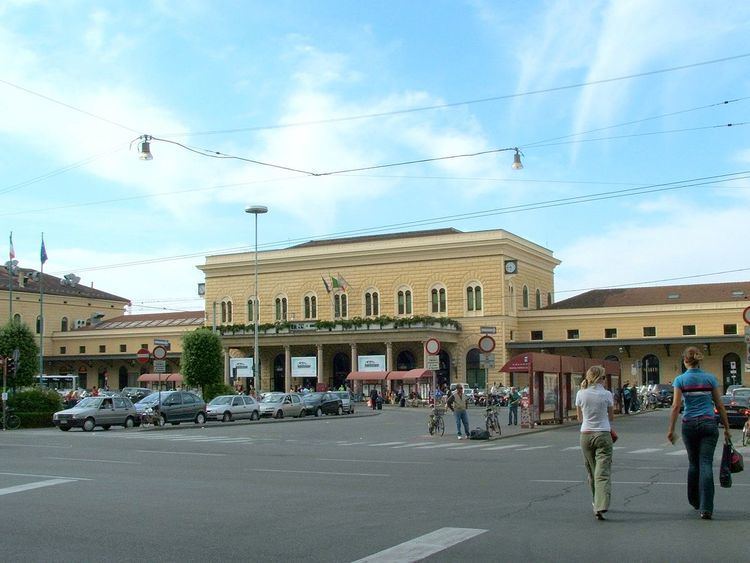Opened 1859 Architect Gaetano Ratti | Distance 96,908 m Platforms in use 27 | |
 | ||
Location Piazza delle Medaglie d'Oro40121 BolognaItaly Line(s) Milan-Bologna (high-speed)Milan-Bologna (traditional)Verona-BolognaPadua-BolognaBologna–AnconaBologna–Florence (high speed)Bologna–Florence (traditional)Bologna–VignolaBologna–PortomaggioreBologna–Pistoia Similar Firenze Santa Maria No, Milano Centrale railway st, Verona Porta Nuova rai, Piazza Maggiore, Venezia Mestre railway st | ||
Italy tour 15 sep 22 2010 firenze s m n to bologna centrale railway station
Bologna Centrale is a railway station in Bologna, Italy. The station is situated at the northern edge of the city centre. It is located at the southern end of the Milan-Bologna high-speed line, which opened on 13 December 2008, and the northern end of three lines between Bologna and Florence: the original Bologna-Florence line through Porretta Terme and Pistoia; the Bologna–Florence Direttissima via Prato, which opened on 22 April 1934 and the Bologna-Florence high-speed line, which opened to traffic on 13 December 2009.
Contents
- Italy tour 15 sep 22 2010 firenze s m n to bologna centrale railway station
- Station
- Bologna Centrale AV
- History
- 1980 terrorist bombing
- Train services
- References
Bologna Central Station is the fifth-busiest in Italy in terms of passenger movements (about 58 million passengers per year). It is, however, one of the busiest, along with Rome Termini Station, for the number of train movements per day (about 800).
Station
There are two levels of railway tracks within the station complex: Bologna Centrale and Bologna Centrale (AV) alta velocità (high speed). The central part of Bologna Centrale contains through tracks for high-speed trains (except Frecciarossa trains which travel only on the Milan-Bologna high-speed line), intercity and regional trains. In addition, there are two groups of side tracks: the western side has six tracks for regional trains from Milan or Verona (with Bologna Centrale as a terminus) and the eastern side has six tracks for regional trains from Prato, Ancona and Pescara (with Bologna Centrale as a terminus).
Bologna Centrale (AV)
In July 2008, Andrea Maffei Architects, Arata Isozaki & Associates, Ove Arup & Partners and M + T & Partners won a competition to design a new station, Bologna Centrale (AV), for high-speed trains between Milan and Florence. The proposal was selected by architect Gae Aulenti, as president of the International Competition Jury, and Rete Ferroviaria Italiana, the main entity behind the competition. The station uses light in its design, with the internal courtyards of the bridged station creating poles of light. Inside the station it is possible to see the levels below, and different shapes of windows were designed for the courtyards.
The new, three-level, railway station was built underneath the current station. It is 642 m (2,106 ft) long and 56 m (184 ft) wide, and consists of three below-ground levels. The first level, at 7 m (23 ft) is for parking, pick-ups and drop-offs. The second level, at 15 m (49 ft), is a shopping arcade. The lowest level, at 23 m (75 ft), consists of four high-speed train platforms (lines 16 to 19).
The underground platforms opened for passenger service on 9 June 2013. Together with the reinstatement of four surface tracks, which were removed to facilitate construction, the project is due to be completed by 2016. The expected cost was €340 million.
This high-speed station is connected by a series of walkways and elevators to the central part. Transfer time is approximately 10 minutes on foot.
History
The first Bologna Centrale station was constructed in 1859, though its history is unclear. A new station was built twelve years later on the same grounds.
The modern station was designed and built by architect Gaetano Ratti, who trained in the local Clementine Academy. Inspired by the neoclassical style, the station's distinctive 15th century façade opens in nine entrance doors. The main passenger building is reminiscent of renaissance Florentine architecture. Until the 1940s, it was topped by a clock tower with marble pillars, but the tower was damaged by allied bombings in the Second World War and not rebuilt.
The original design called for a rectangular shaped, two-faced building, with a marble external façade and a steel internal one. Subsequent extension works, such as the 1926 building of the westbound platforms, shaped the station into the “L” form, typical of expanded transit stations. The introduction of new platforms at the eastern half in 1934, brought another change to the station's configuration.
1980 terrorist bombing
On 2 August 1980 at 10.25 am, an improvised explosive device (IED) made with 20 kilograms of a TNT mixture was detonated inside Bologna's main railway station. The IED was contained in a suitcase, which was placed near the wall inside a lobby. The explosion killed 85 people and injured more than 200. The wing of the station in which the bomb was detonated has been reconstructed but, as a testimony to the victims of the attack, the original pavement was maintained as well as a deep crack in the main wall. Moreover, the station main clock is forever stopped at the exact time of the explosion. The attack is also known in Italy as the Strage di Bologna, the Bologna massacre.
The Italian government immediately accused the Italian neo-fascist militant groups for the attack; however this was denied by the group, and no one ever claimed responsibility. After 15 years, official investigation has determined that the attack was carried out by a small neo-fascist group, call Nuclei Armati Rivoluzionari. Many conspiracy theories regarding this event have been entertained, including a link between this act of terrorism and the Aerolinee Itavia Flight 870 disaster.
Train services
The following services call at the station (incomplete):
Domestic (High-speed) AV Station
Domestic (High-speed)
Domestic
Cross-border
(A for Austria, D for Germany, F for France, GB for Great Britain)
